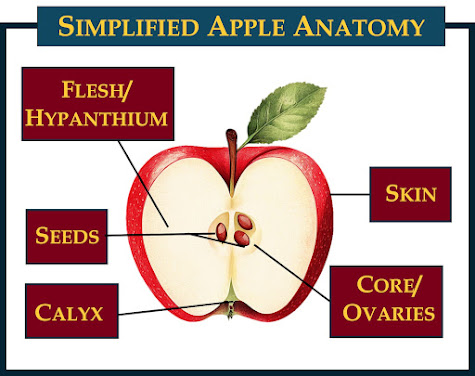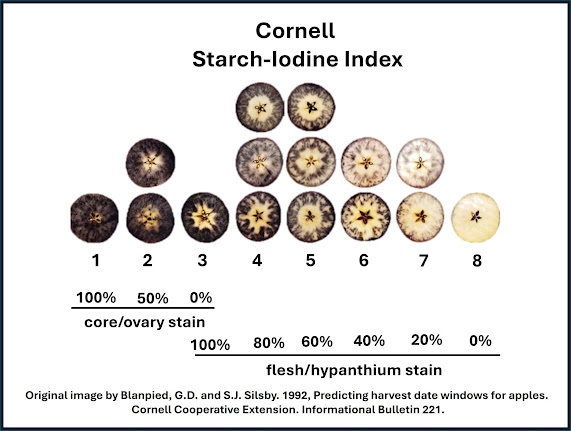Madeline Wimmer- UMN Fruit Production Extension Educator
It’s nearing the end of August and—while many harvest dates have come and gone for fruit crops like honey berries, June-bearing strawberries, currants, and blueberries in many Minnesotan regions—some crops like grapes, apples, aronia berries, and others are tip-toeing into harvest season.
There are a number of ways to determine fruit ripeness for various crops including sensory perceptions: looking at fruit color, smelling for aromatics, and feeling for softness and how easily a fruit to detach from its peduncle (i.e., the stem attached to the fruit).
For some fruit crops, human perception alone can be helpful, but more precise tools exist to measure sugar content, pH, titratable acidity, and starch content. In this article, we’ll explore how to measure fruit ripeness for some of our late-summer and fall fruit crops: apples, grapes, and the aronia berry.

Image: Apples are botanically recognized as accessory fruits because the apple flesh that is eaten is technically a hypanthium, not an ovary, which is the botanical part eaten for true fruits. As apples ripen, first the ovaries and then the fleshy portion convert starch into sugar over time, which is why an iodine-starch test can indicate apple ripeness.
What is a starch-iodine test?
Starch-iodine testing involves spraying an iodine solution on apple flesh (see diagram above). The iodine reacts with the starch leaving a blue stain behind, but does not stain sugars like sucrose, fructose, and glucose. Because apples continue to convert starches into these sugars as they ripen, apples with a larger area of blue stain are less ripe than those with less blue staining.
Growers who anticipate storing apples for longer periods of time may want to consider harvesting apples with slightly more starch/staining since apples do continue to ripen some post-harvest*.
*How much ripening happens and quality of fruit integrity in storage depends on practices like how quickly fruit is cooled, oxygen levels and other storage conditions, and using ethylene action inhibitors.
 Image: The Cornell starch-iodine index chart shows a gradient of starch staining percentages within the apple core and flesh as the McIntosh apples ripen.
Image: The Cornell starch-iodine index chart shows a gradient of starch staining percentages within the apple core and flesh as the McIntosh apples ripen.
Recommended resources for doing an iodine-starch test:
A more extensive article has been included in this week’s newsletter that goes into detail about fruit sampling for grapes. Check out, “Monitor grape cluster ripening for a quality harvest this year,” to read about monitoring fruit ripening in more detail.

Images: Aronia berries can be sold fresh (middle photo), or frozen, and have been incorporated into various beverages such as this bottle of mead from Squash Blossom Farm (left photo; Olmsted County) or this hard apple cider with aronia juice from Canosia Grove (right photo; St. Louis County).
Aronia, also known as chokeberry—but not chokecherry—is a genus of fruit producing shrubs that are native to North America. It’s a unique crop in its ability to survive in USDA Hardiness Zones as cold as Zone 3. The species Aronia melanocarpa (i.e., black chokeberry) is used in fruit production and commonly incorporated into landscapes. Ornamental, or landscaping cultivars include names like Autumn Magic and Morton, however, these are less commonly grown for fruit production purposes (1).
Resources cited:
This fruit update contains information about…
- Determining fruit ripeness
- Apples
- Starch-iodine testing for ripeness.
- Grapes
- Testing grapes for ripeness.
- Aronia
- About aronia berries.
- Viking, an aronia hybrid cultivar.
- Harvest indicators.
- Finding a market for aronia berries
Image: High-density trained apple trees are nearly ready for harvest at Apples R Us, as the orchard anticipates beginning to harvest Minneiska (SweeTango®) and Zestar! within the next week or two. Apples R Us primarily distills their apples into specialty spirits (Olmsted County; Zone 5a).
Determining fruit ripeness
As fruits begin to ripen and approach their anticipated harvest time period, their chemical profiles change dramatically. Acids that contribute to tartness begin to decrease along with “green” flavors, while sugars increase, and flavor and aroma compounds begin to develop. Seeds within fruits begin to mature, and most fruits that we eat physically soften as they ripen—although, “crunch” and “crisp” are both positive attributes for some fruits like fresh-eating apples.There are a number of ways to determine fruit ripeness for various crops including sensory perceptions: looking at fruit color, smelling for aromatics, and feeling for softness and how easily a fruit to detach from its peduncle (i.e., the stem attached to the fruit).
For some fruit crops, human perception alone can be helpful, but more precise tools exist to measure sugar content, pH, titratable acidity, and starch content. In this article, we’ll explore how to measure fruit ripeness for some of our late-summer and fall fruit crops: apples, grapes, and the aronia berry.
Apples
Image: Apples are botanically recognized as accessory fruits because the apple flesh that is eaten is technically a hypanthium, not an ovary, which is the botanical part eaten for true fruits. As apples ripen, first the ovaries and then the fleshy portion convert starch into sugar over time, which is why an iodine-starch test can indicate apple ripeness.
Starch-iodine testing for ripeness
We’ve reached the time of the growing season when some of the earliest University of Minnesota apple cultivated varieties (i.e., cultivars) like First Kiss and Zestar! will be nearing their harvest window in many parts of Minnesota. Most apples show some level of color development as they ripen, plus the classic post-it note yellow background color, as well as a change in flavor profile, sugar development, and a reduction in tartness. However, these indicators can be subjective; thus, one method to assist in more accurate tracking and measuring apple ripeness is to use a starch-iodine test.What is a starch-iodine test?
Starch-iodine testing involves spraying an iodine solution on apple flesh (see diagram above). The iodine reacts with the starch leaving a blue stain behind, but does not stain sugars like sucrose, fructose, and glucose. Because apples continue to convert starches into these sugars as they ripen, apples with a larger area of blue stain are less ripe than those with less blue staining.
Growers who anticipate storing apples for longer periods of time may want to consider harvesting apples with slightly more starch/staining since apples do continue to ripen some post-harvest*.
*How much ripening happens and quality of fruit integrity in storage depends on practices like how quickly fruit is cooled, oxygen levels and other storage conditions, and using ethylene action inhibitors.
Recommended resources for doing an iodine-starch test:
- The Cornell starch-iodine index chart is the standard referenced by the University of Minnesota for recommended starch values.
- Honeycrisp specific index chart, and other apple cultivars (Michigan State University Extension)
- Making an iodine solution (Virginia Tech)
Grapes
Image: The primary aspects of grape juice chemistry that are measured to track fruit ripening are sugar levels measured as soluble solids concentration (SSC), pH, and acidity levels measured as titratable acidity (TA).
Here are some key points from the article:
- Collecting a representative and less-biased sample is important to tracking fruit ripening.
- Sometimes it’s enough to take only one collective sample for a single cultivar, but berry ripening can change depending on how grapes are trained and managed, as well as the interactions between each cultivar and their environment.
- In general, there are three main juice characteristics that are measured to determine fruit ripeness: sugar levels (i.e., soluble solids concentration or SSC), pH, and titratable acidity (TA).
- Which values are acceptable for these attributes will depend on the cultivar, what is realistic for the given growing season and regional conditions, as well as the desired wine style or method used in winemaking.
Aronia
Images: Aronia berries can be sold fresh (middle photo), or frozen, and have been incorporated into various beverages such as this bottle of mead from Squash Blossom Farm (left photo; Olmsted County) or this hard apple cider with aronia juice from Canosia Grove (right photo; St. Louis County).
Aronia, also known as chokeberry—but not chokecherry—is a genus of fruit producing shrubs that are native to North America. It’s a unique crop in its ability to survive in USDA Hardiness Zones as cold as Zone 3. The species Aronia melanocarpa (i.e., black chokeberry) is used in fruit production and commonly incorporated into landscapes. Ornamental, or landscaping cultivars include names like Autumn Magic and Morton, however, these are less commonly grown for fruit production purposes (1).
Viking
The cultivar Viking is probably the most popular aronia berry cultivated in the Upper Midwest, largely because of its reputation for producing bigger fruits with lower astringency, and its tendency to not spread by vegetative growth from rhizomes. Viking was originally developed in the early 1900s by a Russian plant breeder, Ivan V. Michurian, who used traditional breeding methods to incorporate European mountain ash (Sorbus aucuparia) parents into the Viking genome (2). Additionally, Nero is a second well-known cultivar that came from these breeding efforts.Harvest recommendations
Aronia berries often change color and soften as an indication of their readiness for picking, but some Minnesotan aronia fruit producers have speculated that it’s easy to be misled into thinking the berries are ripe and ready to pick the berries before they’ve built up optimum sugar levels. Using a handheld refractometer to determine sugar levels is likely the most accurate method to harvest aronia berries at the optimum time. Wright Farms—one of the largest organic Minnesotan aronia berry producers—recommends harvesting berries when they reach 16 brix (the unit for measuring sugar levels) or higher. They also noted the time in which aronia berries nearly fall off of their peduncles (i.e., fruit stems) upon contact, coincides with their optimum ripening time.Finding a market for aronia berries
Aronia berries are a very sustainable fruit crop to grow. They tend to have fewer pests and disease concerns compared to other major fruit crops. Flavor wise, the berries cannot be compared to blueberries, grapes, honeyberries, or most other fruit crops. There is some critique about aronia’s potential popularity because of its unique flavor profile, but it’s possible that the berries are still waiting to find their niche. And for those who question that possibility, consider the last time it was popular to munch on a bag of fresh cranberries. Yet cranberries have become an American staple used during holiday meals, they’ve been incorporated into popular juice mixes, and they have also been processed to create the famous craisin. For now, the aronia berry is still developing in its reputation with an opportunity to become a fruit that is more widely appreciated for its unique qualities.Resources cited:
- Brand, M.H. 2013. Breeding better aronia plants. https://ena.ipps.org/uploads/docs/63_059.pdf
- Leonard, P.J. 2011. Aronia mitschurinii: Solving a horticultural Enigma. University of Connecticut. Master’s Theses. pp 183.
- Ristvey, A.G. & Matthew, S.A. 2011. Aronia: Cultural and production considerations as an alternative crop. University of Maryland Extension.
❖❖❖❖❖❖❖❖❖❖❖❖❖❖❖❖❖❖❖❖❖❖❖❖❖❖❖❖❖❖❖❖❖❖❖❖❖❖❖❖❖❖❖❖❖❖
The University of Minnesota Extension fruit production program would like to extend a thank-you to our fruit grower partners who make these reports possible.
Non-credited photos in these publications were taken by the author, Madeline Kay Wimmer, M.S.
The University of Minnesota Extension fruit production program would like to extend a thank-you to our fruit grower partners who make these reports possible.
Non-credited photos in these publications were taken by the author, Madeline Kay Wimmer, M.S.

Comments
Post a Comment